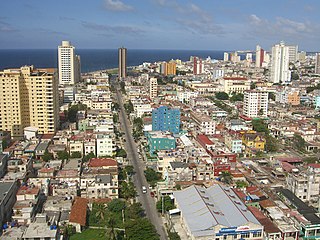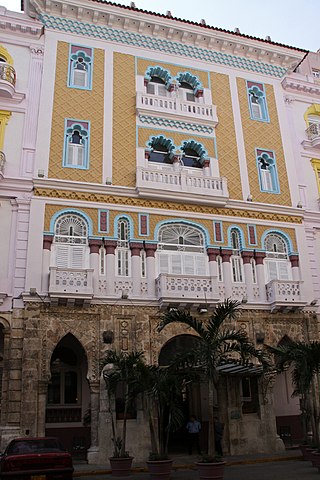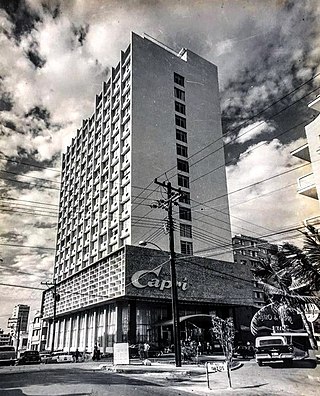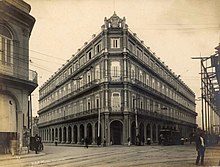
Havana is the capital and largest city of Cuba. The heart of the La Habana Province, Havana is the country's main port and commercial center. It is the most populous city, the largest by area, and the second largest metropolitan area in the Caribbean region. The population in 2012 was 2,154,454 inhabitants, and its area is 728.26 km2 (281.18 sq mi) for the capital city side and 8,475.57 km2 for the metropolitan zone.

Fulgencio Batista y Zaldívar was a Cuban military officer and politician who played a dominant role in Cuban politics from his initial rise to power as part of the 1933 Revolt of the Sergeants until his overthrow in the Cuban Revolution in 1959. He served as elected president of Cuba from 1940 to 1944, and military dictator from 1952 to his 1959 resignation.

Meyer Lansky, known as the "Mob's Accountant", was an American organized crime figure who, along with his associate Charles "Lucky" Luciano, was instrumental in the development of the National Crime Syndicate in the United States.

Santo Trafficante Jr. was among the most powerful Mafia bosses in the United States. He headed the Trafficante crime family from 1954 to 1987 and controlled organized criminal operations in Florida and Cuba, which had previously been consolidated from several rival gangs by his father, Santo Trafficante Sr.
The Havana Conference of 1946 was a historic meeting of United States Mafia and Cosa Nostra leaders in Havana, Cuba. Supposedly arranged by Charles "Lucky" Luciano, the conference was held to discuss important mob policies, rules, and business interests. The Havana Conference was attended by delegations representing crime families throughout the United States. The conference was held during the week of December 22, 1946, at the Hotel Nacional. The Havana Conference is considered to have been the most important mob summit since the Atlantic City Conference of 1929. Decisions made in Havana resonated throughout US crime families during the ensuing decades.

El Tropicana Night Club in Havana, Cuba located in a lush, 36,000-square-metre (390,000 sq ft) estate tropical garden opened on December 30, 1939 at the Villa Mina in Marianao. It is located next door to the old Colegio de Belén, Havana, presently, the Instituto Técnico Militar.

The Hotel Sevilla Habana Affiliated by Meliá is a historic hotel in Havana, Cuba.

Huber Matos Benítez was a Cuban military leader, political dissident, activist, and writer. He opposed the dictatorship of Fulgencio Batista from its inception in 1952 and fought alongside Fidel Castro, Raúl Castro, Che Guevara, Camilo Cienfuegos and other members of the 26th of July Movement to overthrow it. Following the success of the Cuban Revolution that brought Fidel Castro to power, he criticized the regime's shift in favor of Marxist principles and ties to the Popular Socialist Party (PSP). Convicted of treason and sedition by the revolutionary government, he spent 20 years in prison (1959–1979) before being released in 1979. He then divided his time between Miami, Florida, and Costa Rica while continuing to protest the policies of the Cuban government.

Hotel Tryp Habana Libre is one of the larger hotels in Cuba, situated in Vedado, Havana. The hotel has 572 rooms in a 25-floor tower at Calle 23 and Calle L. Opened in 1958 as the Habana Hilton, the hotel famously served as the residence of Fidel Castro and other revolutionaries throughout 1959, after their capture of Havana.

The Hotel Nacional de Cuba is a historic Spanish eclectic style hotel in Havana, Cuba, opened in 1930. Located on the sea front of Vedado district, it stands on Taganana Hill, offering commanding views of the sea and the city.

Oriental Park Racetrack in Marianao, Havana, Cuba, was a thoroughbred horse-racing facility operated during the winter by the Havana-American Jockey Club of Cuba. Founded in 1915, Oriental Park was the only race track in Cuba before Fidel Castro came to power in 1959. It was closed February 5th, 1967.

The Hotel Habana Riviera by Iberostar, originally known as the Havana Riviera, is a historic resort hotel located on the Malecón waterfront boulevard in the Vedado district of Havana, Cuba. The hotel, which is managed by the Spanish Iberostar chain, was built in 1957 and still maintains its original 1950s style. It has twenty-one floors containing 352 rooms all of which feature views of the water and the Vedado neighborhood.

The Hotel NH Capri La Habana is a historic high rise hotel located in central Havana, Cuba.

Havana was founded in the sixteenth century displacing Santiago de Cuba as the island's most important city when it became a major port for Atlantic shipping, particularly the Spanish treasure fleet.

Coliseo de la Ciudad Deportiva is an indoor sporting arena located in Havana, Cuba. Built in 1957, the Coliseum is one of the most important works of Cuban Civil Engineering. It is located at the intersection of Boyeros and Vía Blanca avenues in the Cerro Municipality. The capacity of the arena is for 15,000 spectators.

Sloppy Joe's Bar is a historic bar located in Havana, Cuba. The bar reopened in 2013 after being closed for 48 years.
The following is a timeline of the history of Havana, Cuba.

Cuba and Indonesia established diplomatic relations in 1960. During the administration of Indonesia's first president Sukarno in the 1960s, Indonesia and Cuba enjoyed an exceptionally close relationship. The relations between the two nations mostly focused on sports and health. Cuba has an embassy in Jakarta, while Indonesia has an embassy in Havana that is also accredited to the Commonwealth of the Bahamas and Jamaica. Both nations are full members of the Non-Aligned Movement and partners in the Group of 77 and the Forum of East Asia-Latin America Cooperation.

The Hotel Deauville is a historic hotel in Centro Habana located at Calle Galiano 1 on a corner with the Malecón promenade, and overlooking the Bay of Havana. The hotel was constructed as a casino hotel in 1957 by a consortium owned by American mobster Santo Trafficante Jr.

The Havana Plan Piloto was a 1955–1958 urban proposal by Town Planning Associates, which included Paul Lester Wiener, Paul Schulz, the Catalan architect Josep Lluis Sert, and Seely Stevenson of Value & Knecht, Consulting Engineers, seeking to combine "architecture, planning, and law". The Charter got its name from the location of the fourth CIAM conference in 1933, which, due to the deteriorating political situation in Russia, took place on the "in SS Patris II" bound for Athens from Marseilles. This conference is documented in a film commissioned by Sigfried Giedion and made by his friend László Moholy-Nagy. The Charter had a significant impact on urban planning after World War II and, through Josep Lluis Sert and Paul Lester Wiener, on the proposed modernization of Havana and in an effort to erase all vestiges of the 16th-century city. The plan was abandoned and was not made.




















